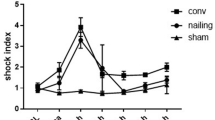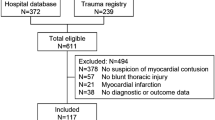Abstract
We sought to investigate the role of two-dimensional stress echocardiography in the early assessment of myocardial contusion. For this purpose, 12 dogs, weighing 11.36 ± 1.50 kg, were selected and the myocardial contusion was experimentally induced. Two-dimensional dobutamine stress echocardiography (DSE) was used to detect abnormal myocardial motions segments at time phases of baseline and 0.5, 2, 4, and 8 h post-wounding. Finally, the above results were compared with pathological findings. The data show that after the dogs were induced to have severe myocardial contusion, 122 segments were found with abnormal myocardial wall motions at 0.5 h post-wounding, 133 segments at 2 h post-wounding, and 142 segments, each, at 4 h and 8 h post-wounding. The wall motion score (WMS) and wall motion score index (WMSI) increased (P < 0.001) as compared with the pre-impaction values. Considering the left ventricular axis view as the standard section, in the 60 segments examined by echocardiography, 54 segments were found to have wall motion abnormalities. Comparing with the results of pathological TTC staining, the sensitivity and specificity were found to be 100 and 66.6%, respectively. It was, therefore, concluded that two-dimensional DSE was a valuable technique in the early diagnosis of myocardial contusion due to its better sensitivity and specificity.


Similar content being viewed by others
References
Liedtkl, A. J., & DeMuth, W. E. (1973). Non-penetrating cardiac injury: A collective review. The Journal of Trauma, 86, 687–697.
Aksnes, J., Foose, E., Pilgrim, L. J., & Field, N. (1993). Injury of the heart. Injury, 24, 545–548.
Olsovsky, M. R., Wechsler, A. S., & Topaz, O. (1997). Cardiac trauma: Diagnosis, management, and current therapy. Angiology, 48, 423–432.
Cooper, G. J., Pearce, B. P., Stainei, W. E., & Maynard, R. L. (1982). The biochemical response of the thorax to non-penetrating impact with particular reference to cardiac injury. The Journal of Trauma, 22, 994–1008.
Liedtkl, A. J., Gault, W. E., & DeMuth, W. E. (1974). Electrocardiographic and hemodynamic changes following non-penetrating chest trauma in the experimental animal. American Journal of Physiology, 226, 377–382.
Guan, D. W., Zhang, X. G., Zhao, R., Lu, B., Han, Y., Hou, Z. H., et al. (2007). Diverse morphological lesions and serious arrhythmias with hemodynamic insults occur in the early myocardial contusion due to blunt impact in dogs. Forensic Science International, 166, 49–57.
Kaye, P., & O’Sullivan, I. (2002). Myocardial contusion: Emergency investigation and diagnosis. Emergency Medicine Journal, 19, 8–10.
Roxburgh, J. C. (1996). Myocardial contusion—a review. Injury, 27, 603–605.
Feghali, N. T., & Prisant, L. M. (1995). Blunt myocardial injury. Chest, 108, 1673–1677.
van Wijngaarden, M. H., Karmy-Jones, R., Talwar, M. K., & Simonetti, V. (1997). Blunt cardiac injury: A ten year institutional review. Injury, 28, 51–55.
Pretre, R., & Chilcott, M. (1997). Blunt trauma to the heart and great vessels. The New England Journal of Medicine, 336, 626–632.
Blair, E., Topuzlu, C., & Davis, J. H. (1971). Delayed or missed diagnosis in blunt chest trauma. The Journal of Trauma, 11, 129–145.
Beresky, R., Klingler, R., & Peake, J. (1988). Myocardial contusion: When does it have clinical significance? The Journal of Trauma, 28, 64–68.
Driscoll, P. A. (1992). Trauma: today’s problems and tomorrow’s answers. Injury, 23, 151–158.
Wisner, D. H., Reed, W. H., & Riddick, R. S. (1990). Suspected myocardial contusion. Triage and indications for monitoring. Annals of Surgery, 212, 82–86.
Robert, E., de La Coussaye, J. E., Aya, A. G., et al. (2000). Mechanisms of ventricular arrhythmias induced by myocardial contusion: A high-resolution mapping study in left ventricular rabbit heart. Anesthesiology, 92, 1132–1143.
Garcia-Fernandez, M. A., Lopez-Perez, J. M., Perez-Castellano, N., et al. (1998). Role of transesophageal echocardiography in the assessment of patients with blunt chest trauma: Correlation of echocardiographic findings with the electrocardiogram and creatine kinase monoclonal antibody measurements. American Heart Journal, 135, 476–481.
Fabian, T. C., Cicala, R. S., Croce, M. A., et al. (1991). A prospective evaluation of myocardial contusion: Correlation of significant arrhythmias and cardiac output with CPK-MB measurements. The Journal of Trauma, 31, 653–659.
Schick, T. D., van der Zee, H., & Powers, S. R, Jr. (1977). Detection of cardiac disturbances following thoracic trauma with high-frequency analysis of the electrocardiogram. The Journal of Trauma, 17, 419–424.
Schultz, J. M., & Trunkey, D. D. (2004). Blunt cardiac injury. Critical Care Clinics, 20, 57–70.
Diebel, L. N., Robinson, S. L., Wilson, R. F., & Dulchavsky, S. A. (1993). Splanchnic mucosal perfusion effects of hypertonic versus isotonic resuscitation of hemorrhagic shock. American Journal of Surgery, 59, 495–499.
Chirill, F., Totis, O., Cavarzerani, A., et al. (1996). Usefulness of transthoracic and transesophageal echocardiography in recognition and management of cardiovascular injuries after blunt chest trauma. Heart, 75, 301–306.
Brooks, S. W., Cmolik, B. L., Yong, J. C., Townsend, R. N., & Diamond, D. L. (1991). Transesophageal echocardiographic examination of a patient with traumatic aortic transaction from blunt chest trauma: A case report. The Journal of Trauma, 31, 841–845.
Vignon, P., Martaillé, J. F., François, B., Rambaud, G., & Gastinne, H. (2005). Transesophageal echocardiography and therapeutic management of patients sustaining blunt aortic injuries. The Journal of Trauma, 58, 1150–1158.
Miller, F. A., Seward, J. B., & Tojik, A. J. (1982). Two-dimensional echocardiographic finding in cardiac failure. American Journal of Cardiology, 50, 1022–1027.
Mooney, C. B, Jr., Fabian, T. C., & Croce, M. A. (1998). Determination of myocardial performance after blunt chest trauma. The Journal of Trauma, 45, 988–996.
Acknowledgments
The authors thank the Open Fund of State Key Laboratory of Trauma, Burn and Combined Injury of the Third Military Medical University, China for financial support. The authors are also grateful to professors Jiang JX and Yin ZY from the Research Institute of Surgery for their technical and clinical guidance in this study.
Author information
Authors and Affiliations
Corresponding author
Rights and permissions
About this article
Cite this article
Du, W., Xiong, X., Yang, W. et al. Dobutamine Stress Echocardiography Assessment of Myocardial Contusion due to Blunt Impact in Dogs. Cell Biochem Biophys 62, 169–175 (2012). https://doi.org/10.1007/s12013-011-9278-1
Published:
Issue Date:
DOI: https://doi.org/10.1007/s12013-011-9278-1




